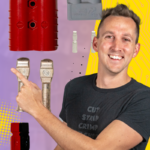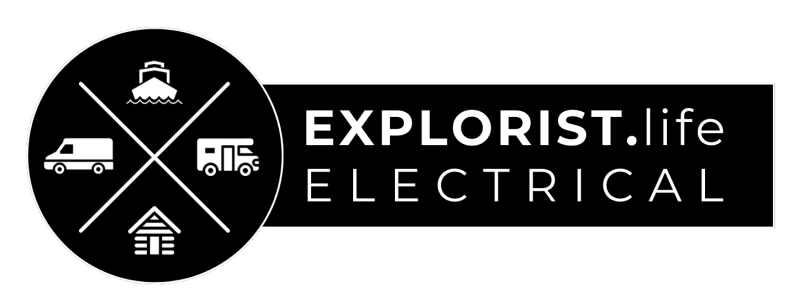
Anderson connectors are our connector of choice for making a connection between a truck and trailer for DC DC charging, but there are also smaller versions for smaller things like lights or outlets, and you can also see these on the front of a lot of portable power boxes.

Anderson Connector Crimping – VIDEO

What are the parts of an Anderson connector?

Anderson connectors come with two electrical terminal pins and a connector housing:
- The electrical terminal pins are crimped onto the ends of the wire
- The pins then snap into the connector housing
What Crimper is Best for Anderson Connectors?
Anderson Connectors 10AWG and Smaller
For Anderson connectors 10 AWG and smaller, I like to use non-insulated ratcheting crimpers; the same ones we use for PV connectors.

The jaws of this connector have a ‘U’ shape on one side and an m shape on the other.
Notice that these Anderson terminal pins have a little ‘break’ on one side of the barrel connector.

I put the terminal into the crimper with the ‘tooth’ of the ‘m’ pushing right on top of the split of the barrel connector. When I do this, the crimper rolls the terminal into basically two crimps, pushing the top of the connector to the middle.
And here’s how that looks with wire:
- Put the terminal into the crimper
- Put the stripped wire into the terminal
- Squeeze the crimper until the crimper releases
- Give the terminal a tug to make sure it’s secure

Anderson Connectors Larger than 10 AWG
Crimping anderson connectors larger than 10 AWG is the exact same process, just using a different crimper.
The crimper I like for this is this battery lug crimper from Temco. If you need a refresher on how this crimper works, review lesson 4.05 of this academy wherre we covered how to crimp wire lugs.
Changes from Nate here.
How to Make an Anderson Connector

Once the pins have been crimped onto the wire, they can simply be pushed into place, but they have to go the right direction. Notice the little metal retainer plate inside of the connector housing? The ‘hook’ of the terminal pin needs to ‘grab’ onto that plate; so put the wire into the terminal, and push it until it clicks into place and then visually inspect to make sure the hook is completely over that retaining plate.

This process is the same regardless of what size of connector you are using.
Also, take special care to make sure that the correct wire is in the correct side of the housing. Red to red, and black to black for example.

If you mess up, you can simply reach inside of the connector with a small screwdriver, push the plate down, and pull the wire out to try again.
What are some common use cases for Anderson Connectors?
We most typically use Anderson connectors for the DC DC charging circuit to connect 4 or 6 AWG wires from the truck to the trailer.

We have also used them in our van to add lights and power to the modular cabinets in our Transit camper van with Anderson Connector wall plates.
So, for a quick-disconnect option for low voltage DC power; these are pretty great and they actually come in sizes up to huge 4/0 versions.
Conclusion
Now we are going to be putting anderson connectors on a lot of wires throughout the rest of this academy, so be sure to bookmark this lesson for future reference and come back to it if you need a refresher because going forward, I’ll just assume that you now know how to crimp and assemble an anderson connector
